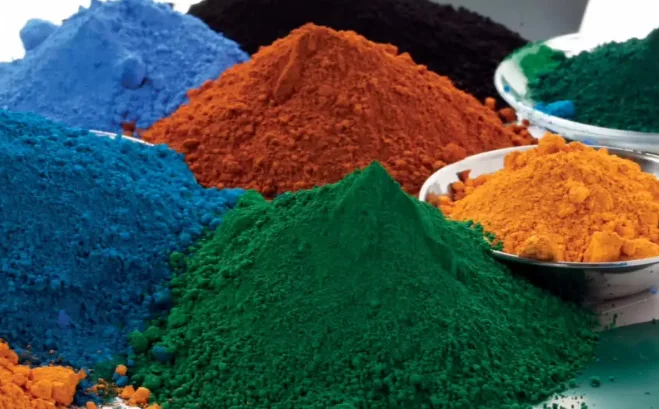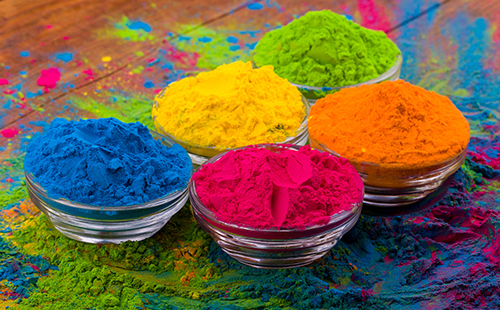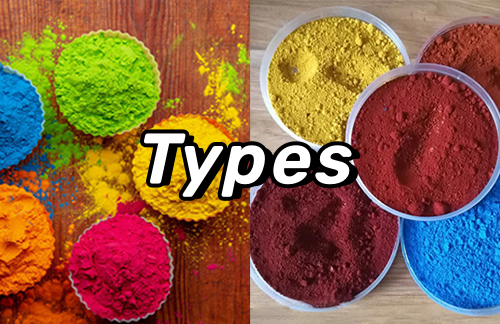Which types of inorganic pigments are available?
Inorganic pigments are important in industries, paintings and arts, which are widely applied in building materials, plastics, rubber, coatings, paints, inks, etc. They are reliable in variable applications because of high stability, light fastness and weather fastness. In this article, KingChroma Chemical introduces common inorganic pigments as well as their properties and applications.

Iron oxide pigments:
Properties: Iron oxide pigments have rich colors and high covering power, usually including iron oxide red, iron oxide yellow, iron oxide brown, iron oxide black, etc.
Applications: They are widely applied as durable and attractive colorants in buildings, paints, ceramics and arts.
2. Titanium dioxide pigments:
Properties: Titanium dioxide pigments are common white pigments because of high covering power and light scattering ability.
Applications: They are used the most as white pigments in paints, rubber, paper and the like for higher brightness and covering power.
Carbon black pigments:
Properties: Carbon black pigments feature dark colors, high covering power and light adsorption capacity.
Applications: They are used the most as black pigments for deep darkening of inks, paints, plastics, rubber, etc.
Ultramarine pigments:
Properties: Ultramarine pigments are charmingly dark blue, with high color stability and covering power, but most of them are not acid-resistant. Common types are ultramarine blue and ultramarine purple.
Applications: They are applied extensively for some whitening effects in art paintings, plastics, coatings, inks, buildings, leather, paper, etc.
Chrome oxide pigments:
Properties: Chromic oxide pigments are characterized by unique tone, bright color, heat fastness, weather fastness, corrosion resistance and chemical stability, mainly including chromium oxide green, chromium yellow and chromium red.
Applications: They are mainly for lasting colors and high durability in paints, inks, plastics, ceramics, glass, etc.
Bismuth vanadate yellow pigment:
Properties: Bismuth vanadate yellow pigments have bright yellow color and high fastness to light and weather.
Applications: They are widely applied for bright and lasting colors in coatings, paints, plastics, arts, handicrafts, etc.
Cobalt blue and cobalt green pigments:
Properties: Cobalt blue pigments and cobalt green pigments have bright and full color and high heat fastness (up to 1,000℃), color stability and durability.
Applications: They are widely applied for vivid and lasting colors in paints, ceramics, glass, plastics and arts.
Cadmium oxide pigments:
Properties: Cadmium oxide pigments have high color stability and durability, ranging from yellow to red. But they may contain toxic cadmium, posing threats to the environment and health.
Applications: They are widely applied for abundant colors and high color stability in paints, inks, plastics, rubber, ceramics, colored glass, etc.
Inorganic pigments play an important role for rich lasting colors in various fields. Understanding their properties and applications is helpful to choose appropriate ones for more attractive and durable products.
Which types of organic pigments are available?
Organic pigments are insoluble colorants with bright color, high coloring power, extensive varieties and complete chromatography, covering almost all visible spectrums. In view of chemical structures, common organic pigments include azo pigments (mono azo pigments, bisazo pigments, azo lake pigments, macromolecular azo pigments, etc.), phthalocyanine pigments, naphthol pigments, quinacridone pigments, dioxazine pigments and other special pigments.

Azo pigments
Azo pigments are organic pigments that contain azo groups and are water-insoluble, with the most varieties and largest output (about 60% of the total output of organic pigments). Due to wide chromatography, bright color, high coloring power and high light fastness, azo pigments are widely used in inks, paints, rubber, plastics, printing pulp, paper, cultural and educational supplies, cosmetics, etc.
By the number of azo groups in molecules or structural characteristics of diazo and coupling components, azo pigments are further divided into mono azo pigments, bisazo pigments, azo lake pigments, macromolecular azo pigments, etc.
Mono azo pigments
Mono azo pigments are colorants containing one azo group only, mainly including insoluble azo pigments and azo lake pigments. They are mostly yellow, orange or red. They also feature low molecular weight, simple structure, bright color, high coloring power, high durability and medium fastness, so they are mainly applied in inks.
Bisazo pigments
Bisazo pigments are organic pigments containing two azo groups. Due to relatively complex production processes, they have high solvent fastness and migration fastness but low light fastness. They are mainly applied in general-purpose printing inks and plastics, but less in paints.
Azo lake pigments
Azo lake pigments are water-insoluble, which are made with water-soluble dyes and precipitating agents. They have brighter color, wider chromatography and higher light fastness than water-soluble dyes, but can be produced like general-purpose mono azo pigments. They are mainly yellow and red, and widely applied in paints, inks, printing and dyeing, plastic products, paper, rubber products, ceramics, etc.
Macromolecular azo pigments
Macromolecular azo pigments are similar to general-purpose bisazo pigments in term of the molecular structure. They are made through condensation of two mono azo pigments containing carboxylate groups with aromatic diamine. Despite complex production processes, they have high fastness to light, solvents and migration, so they are mainly used to color the stock solution for plastics and synthetic fibers.
Phthalocyanine pigments
Phthalocyanine pigments (mainly blue and green) are water-insoluble organic compounds containing phthalocyanine molecules, mainly including copper-containing phthalocyanine blue pigments. They are coarse products made through reaction of phthalic anhydride, urea and cuprous chloride in the presence of ammonium molybdate (catalyst).
Phthalocyanine pigments are polycrystalline, which are usually of α (red) and β (green) crystal types. They have high color brightness, coloring power, heat fastness and light fastness. Due to fine particles, phthalocyanine pigments can be easily diffused, processes and ground. They are mainly used in inks, tin printing, paints, watercolor paints, oil color paints, pigment printing and rubber/plastic products.
Naphthol pigments
In term of the chemical structure, naphthol pigments are mono azo pigments (mainly orange and red), which are made with naphthol as a coupling component but different from yellow and orange mono azo pigments. They feature high light fastness, solvent fastness and migration fastness but no alkali resistance, so they are often used in paints and coatings with high light fastness.
Quinacridone pigments
Quinacridone pigments (mostly red and purple) are organic pigments that are made through self-condensation, aniline condensation, closed loop reaction, refining and oxidation of diethyl succinate. Due to high color brightness, comprehensive color fastness, migration fastness, solvent fastness and heat fastness (up to 300°C), they are widely applied to color the stock solution for high-grade inks, paints, plastics and synthetic fibers.
Dioxazine pigments
Dioxazine pigments are bright purple, containing carbazole dioxazine. They are excellent plastic colorants because of high coloring power, heat fastness, light fastness and solvent fastness.

More information about Organic Pigments and Inorganic Pigments, you can check: Organic Pigments VS Inorganic Pigments
Related Blogs
What Approaches Could Be Applied to the Modification of Organic Pigments?
OUR Organic and Inorganic PIGMENT PRODUCTS



